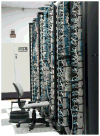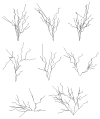Towards a large-scale biologically realistic model of the hippocampus
- PMID: 23366951
- PMCID: PMC4172354
- DOI: 10.1109/EMBC.2012.6346990
Towards a large-scale biologically realistic model of the hippocampus
Abstract
Real neurobiological systems in the mammalian brain have a complicated and detailed structure, being composed of 1) large numbers of neurons with intricate, branching morphologies--complex morphology brings with it complex passive membrane properties; 2) active membrane properties--nonlinear sodium, potassium, calcium, etc. conductances; 3) non-uniform distributions throughout the dendritic and somal membrane surface of these non-linear conductances; 4) non-uniform and topographic connectivity between pre- and post-synaptic neurons; and 5) activity-dependent changes in synaptic function. One of the essential, and as yet unanswered questions in neuroscience is the role of these fundamental structural and functional features in determining "neural processing" properties of a given brain system. To help answer that question, we're creating a large-scale biologically realistic model of the intrinsic pathway of the hippocampus, which consists of the projection from layer II entorhinal cortex (EC) to dentate gyrus (DG), EC to CA3, DG to CA3, and CA3 to CA1. We describe the computational hardware and software tools the model runs on, and demonstrate its viability as a modeling platform with an EC-to-DG model.
Figures



References
-
- Hines ML, Carnevale NT. The NEURON simulation environment. Neural Computation. 1997;9:1179–1209. - PubMed
-
- Oliphant Travis E. Python for Scientific Computing. Computing in Science and Engineering. 2007 May-Jun;9(3):10–20.
-
- Hillman DE. The Neurosciences, 4th Study Program. MIT Press; Cambridge: 1979. Neuronal Shape Parameters and Substructures as a Basis of Neuronal Form; pp. 477–498.
-
- Ascoli G, Krichmar JL. L-Neuron: A Modeling Tool for the Efficient Generation and Parsimonious Description of Dendritic Morphology. Preprint of Article to appear in Neurocomputing. 2000
Publication types
MeSH terms
Grants and funding
LinkOut - more resources
Full Text Sources
Miscellaneous
